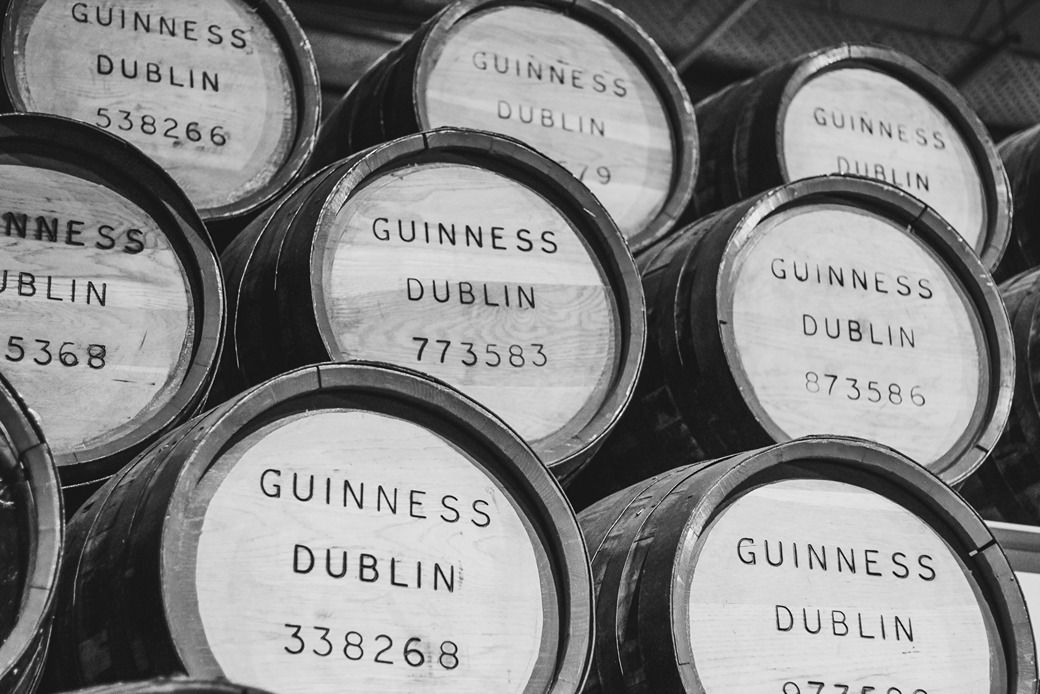Sláinte
In Dublin, Ireland, 1759, Arthur Guinness signed a 9,000-year lease for St. James's Gate Brewing with the intent on producing a variety of beers.

An inheritance from his godfather had allowed Guinness to pursue his passion for brewing. The asking price? £45 per year. The emphasis, rightfully so, would be on ales. However, only 40 years after its founding in 1799, Arthur pivoted in what would be a legacy-defining decision—opting to focus on an unexpected front-runner—the stout. He had his work cut out for him.
A bonafide entrepreneur turned eventual innovator and brew master, Arthur honed in on this particular style of porter—a rich, complex flavor with hints of chocolate, malt, and coffee, darker in color than the traditional beers. By the 1840s the Guinness Stout's distinctive flavor profile and appearance was the foundation for Arthur Guinness and St. James's Gate Brewing to produce an internationally renowned beer.
A Beer Symbolic of Irish Culture and Pride
By the mid-19th century, Guinness Stout had expanded significantly beyond its Irish borders both in size and reputation. Throughout the late 19th and 20th centuries, the locally operated brewery in Ireland was now an internationally-recognized brand with deep roots firmly planted in Ireland's cultural heritage and identity. Guinness became a direct representation of the proud Irish people.

As the brewery grew, Irish pride swelled along with it. While Irish immigration increased throughout the world across the United States, Britain, and beyond, so did the popularity of Guinness. Raising a pint became more than a means to quench one's thirst. It was a toast to the homeland. Irish pubs worldwide began to feature it, further strengthening its Irish identity and turning the drink into a symbol of hospitality and the Irish way of living. If you don't carry Guinness, you are not a proper Irish pub. Those rules applied then, and they sure as hell apply now. But it is in festivities that Guinness' ties to Irish identity are most evident.
St. Patrick's Day
Celebrated annually on March 17, St. Patrick's Day is the commemoration of the death of St. Patrick, the patron saint of Ireland who's responsible for bringing about Christianity to the Irish people. The 9th century Catholic feast day has since morphed into a globally-recognized celebration of Irish heritage, especially in areas with densely-populated Irish, such as New Orleans' Irish Channel.
Escaping extreme poverty, famine, and British oppression, Irish immigrants began arriving in New Orleans in the late 1700s and found their community on the riverside of Magazine Street adjacent to the wealthy Garden District. These Irish laborers' contribution to the city was to construct many of the city's levees and canals under grueling heat and difficult conditions. Who wouldn't need a beer after that day of work?

The thriving immigrants formed Irish social and benevolent organizations and celebrated their patron saint in New Orleans in 1809 for the first time.
Gathering together in traditional green garb and sporting shamrocks (as a symbol of the Holy Trinity) to pay homage to St. Patrick are commonplace. Today, wearing of the green at New Orleans' Irish Channel Parade without a pint of Arthur Guinness' stout in hand is akin to sacrilegious.
Guinness & New Orleans
Although Guinness was introduced to the United States in 1817, its popularity in the United States expanded with the Irish immigration in the 1840s and then exploded after rolling out its draught in 1959 to mark 200 years of brewing. However, its introduction to New Orleans is largely credited to Crescent Crown Distributing (originally Crown Distributing), who began as a five-truck start up in August 1982. Crescent Crown's risk in being on the ground-floor of this stout was a game changer and propelled their company while altering the beer drinking landscape in the Crescent City forever. They remain the sole distributor in southern Louisiana. Initially available at only a few watering holes including Cooter Brown's, the stout's popularity skyrocketed quickly among the nearby universities' college crowds and was suddenly in high demand throughout the city.
There are at least 34 bars, pubs, and restaurants offering Guinness on tap in New Orleans, including Irish-themed favorites Erin Rose, Finn McCool's Irish Pub, St. Pat's Coffeehouse, Fahy's Irish Pub, Ryan's Irish Pub, Molly's at the Market, Boondock Saint, and Molly's Irish Pub, building a solid base on the iconic Irish go-to. With Guinness ownership now with UK-based Diageo, even Brooks Reitz's newbie British pub The Bell leads their beer list with a 20-ounce Guinness stout as their house favorite.
In the U.S., Guinness is estimated to sell about a million barrels a year.
"75,000 cases of Guinness are sold annually in Louisiana," said distribution rep Nick Krizic of Diageo Beer Company, the corporation that owns the Guinness brand.
Given that New Orleans ranks third in per capita consumption of alcoholic beverages with over 3,000 saloons, bars, and other establishments licensed to sell alcoholic beverages in New Orleans—along with an estimate of well over 25,000 gallons of beer consumed in the Superdome during Super Bowl based on previous years—it's safe to conclude a significant amount of Guinness flows through the city that care forgot.
And if you are of legal drinking age, know that a Guinness is always—always—a good idea. Sláinte!

